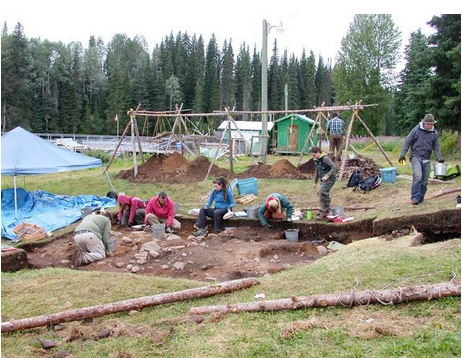Terri Theodore
Source - http://www.vancouversun.com/technology/Ancient+village+along+river+reveals+1300+years+First+Nations/7415957/story.html

University of Northern British Columbia researchers dig on the shores of Babine River, B.C. in this recent handout photo. THE CANADIAN PRESS/HO, UNBC
Along the banks of B.C.'s Babine River sits an archeological treasure trove, an ancient village that may have been used as a crossroad for First Nations dating back more than 1,300 years.
While the Babine Lake First Nation knew their ancestors' village was there, it's untilled ground for archeologists.
Before the arrival of Prof. Farid Rahemtulla and his crew from the Department of Anthropology at the University of Northern British Columbia, experts hadn't searched the site.
"It's just one of those places that hasn't really been explored very well in terms of archaeology," Rahemtulla said in an interview.
The village site is about 100 kilometres from Smithers in B.C.'s northern Interior.
It runs for at least 700 metres along the river and is obvious even to an amateur that the place is special.
"In addition to the house remains, which we excavated this year, there were also about 1,000 cultural depressions which are used for caching food and other materials."
In fact, Rahemtulla says there are eight to 10 long houses on the site, which could have housed many families.
After a preliminary dig in 2010 at the invitation of the Babine Lake First Nation, Rahemtulla and his crew were invited to return this year and excavate one of the homes.
Layer upon layer, they dug up artifacts that seem to follow a historic time line; arrow heads and spear points, old musket balls and flints for flint-lock rifles, right up to cartridges from modern-day firearms.
"It was really quite amazing to see the whole range of tools and weapons going back to probably long before Europeans arrived, right to the point where European goods were available and then even into much more recent times.
"We were finding bits of clothing and harmonica's ... and all the kinds of things that would have been available probably when Hudson's Bay set up its post nearby."
Radio carbon-dating from artifacts pulled up during their 2010 dig found the settlement was occupied more than 1,300 years ago.
Rahemtulla says major trails lead into and out of the village and could have been used for trade exchanges at the village long before Europeans arrived.
The village was abandoned about 200 years ago.
The Babine Lake First Nation historical timeline on its website says cannery operators down river complained that the aboriginal fishing weirs threatened their supply.
After First Nations were prohibited from putting up the weirs, the village faced starvation, fish wardens sent reports that the Babine people were starting an uprising and a 100-strong militia was sent into the community. Nine Babine members surrendered and were jailed in September 1906.
The economy of the Babine band later shifted from relying on salmon to trapping and the fur trade.
"Some of the people that we'd worked with had stories of their grandmother living there, one of the last people who actually lived in that village," Rahemtulla said. "What we're tying to get a handle on is how far back the village goes and what were people doing there."
Their dig has been hampered by B.C.'s forest soils that don't allow for the preservation of organic materials. They quickly disappear, Rahemtulla said.
But Rahemtulla said what researchers have found is starting to reveal the story of how these people functioned, decorated their homes, survived and thrived.
"We're just starting to scratch the surface of what's really there," Rahemtulla said.
Chief Wilfred Adam of the Lake Babine Nation said the findings so far confirm the histories that their elders have passed down through the generations.
"It is gratifying to see multi-year projects such as this one moving ahead. We look forward to working with UNBC on many more projects in the future," Adam said in a statement.
But the entire site hasn't been left untouched. It's still a popular fishing area for First Nations and the Department of Fisheries and Oceans has a fish counting fence at the site, which includes a compound with buildings.
"It has, unfortunately, been disturbed," Rahemtulla said.